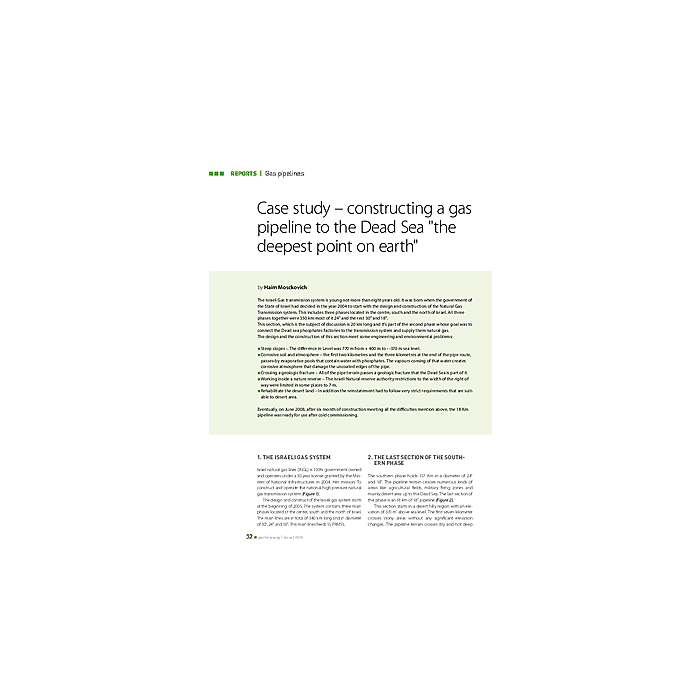Case study - constructing a gas pipeline to the Dead Sea "the deepest point on earth"
4,90 €
Auf Lager
Artikelnummer
00258_2012_02_02
The Israeli Gas transmission system is young not more than eight years old. It was born when the government of the State of Israel had decided in the year 2004 to start with the design and construction of the Natural Gas Transmission system. This includes three phases located in the centre, south and the north of Israel. All three phases together were 350 km most of it 24" and the rest 30" and 18".This section, which is the subject of discussion is 20 km long and it's part of the second phase whose goal was to connect the Dead sea phosphates factories to the transmission system and supply them natural gas.The design and the construction of this section meet some engineering and environmental problems: - Steep slopes. The difference in Level was 770 m from + 400 m to -370 m sea level. - Corrosive soil and atmosphere - the first two kilometres and the three kilometres at the end of the pipe route, passes by evaporative pools that contain water with phosphates. The vapours coming of that water creates corrosive atmosphere that damage the uncoated edges of the pipe. - Crossing a geologic fracture - All of the pipe terrain passes a geologic fracture that the Dead Sea is part of it. - Working inside a nature reserve - The Israeli Natural reserve authority restrictions to the width of the right of way were limited in some places to 7 m. - Rehabilitate the desert land - In addition the reinstatement had to follow very strict requirements that are suitable to desert area. Eventually, on June 2008, after six month of construction meeting all the diffculties mention above, the 18 Km pipeline was ready for use after cold commissioning.
| Autoren | Haim Mosckovich |
|---|---|
| Erscheinungsdatum | 01.02.2012 |
| Format | |
| Zeitschrift | gas for energy - Issue 02 2012 |
| Verlag | DIV Deutscher Industrieverlag GmbH |
| Sprache | English |
| Seitenzahl | 5 |
| Titel | Case study - constructing a gas pipeline to the Dead Sea "the deepest point on earth" |
| Beschreibung | The Israeli Gas transmission system is young not more than eight years old. It was born when the government of the State of Israel had decided in the year 2004 to start with the design and construction of the Natural Gas Transmission system. This includes three phases located in the centre, south and the north of Israel. All three phases together were 350 km most of it 24" and the rest 30" and 18".This section, which is the subject of discussion is 20 km long and it's part of the second phase whose goal was to connect the Dead sea phosphates factories to the transmission system and supply them natural gas.The design and the construction of this section meet some engineering and environmental problems: - Steep slopes. The difference in Level was 770 m from + 400 m to -370 m sea level. - Corrosive soil and atmosphere - the first two kilometres and the three kilometres at the end of the pipe route, passes by evaporative pools that contain water with phosphates. The vapours coming of that water creates corrosive atmosphere that damage the uncoated edges of the pipe. - Crossing a geologic fracture - All of the pipe terrain passes a geologic fracture that the Dead Sea is part of it. - Working inside a nature reserve - The Israeli Natural reserve authority restrictions to the width of the right of way were limited in some places to 7 m. - Rehabilitate the desert land - In addition the reinstatement had to follow very strict requirements that are suitable to desert area. Eventually, on June 2008, after six month of construction meeting all the diffculties mention above, the 18 Km pipeline was ready for use after cold commissioning. |
Eigene Bewertung schreiben


